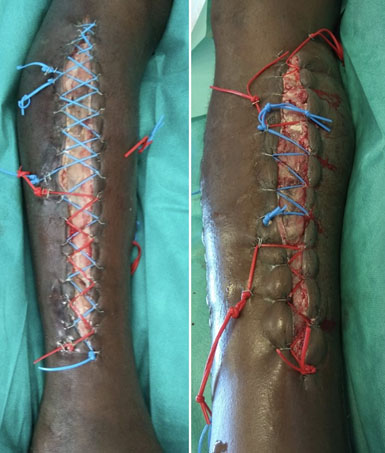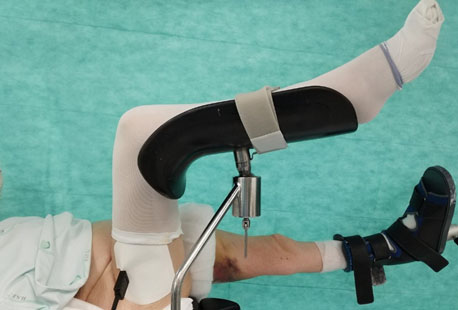 |
Case Series
Well leg compartment syndrome after orthopedic surgery in hemilithotomy position: A case series
1 MD, Centro Hospitalar Lisboa Ocidental, Lisbon, Portugal
Address correspondence to:
Raquel Teixeira
Estrada do Forte do Alto do Duque, Lisbon,
Portugal
Message to Corresponding Author
Article ID: 100020O03RT2021
Access full text article on other devices

Access PDF of article on other devices

How to cite this article
Teixeira R, Ribeiro H, Fernandes P, Caetano AC. Well leg compartment syndrome after orthopedic surgery in hemilithotomy position: A case series. Edorium J Orthop 2021;7:100020O03RT2021.ABSTRACT
Introduction: Well leg compartment syndrome is a rare complication that occurs in the uninjured limb related to prolonged surgical procedures in lithotomy or hemilithotomy position. There are only 20 cases reported associated with orthopedic surgery.
Case Series: We report the two cases of young male patients who underwent orthopedic surgery and were positioned who underwent orthopedic surgery and were positioned in hemilithotomy position. The surgical time was longer than expected in both surgeries, surpassing 4 hours. 6 and 12 hours post-surgery, patients complained of unwarranted pain and paresthesia on the uninjured leg. Due to high suspicion of well leg compartment syndrome, intracompartment pressures were measured and found to be elevated. Although emergent fasciotomy was performed in both cases, one patient suffered permanent neurological deficit, while the other made a complete recovery.
Conclusion: This complication, although infrequent in orthopedic surgery, can occur in even short surgical procedures. Orthopedic team awareness can lead to prevention or timely treatment, improving the chances for total recovery.
Keywords: Compartment syndrome, Postoperative complications, Trauma
INTRODUCTION
Well leg compartment syndrome (WLCS) is a rare complication that refers to the occurrence of compartment syndrome in an uninjured limb related to prolonged surgical procedures in the lithotomy or hemilithotomy position [1]. This iatrogenic compartment syndrome was first described by Leff and Shapiro in 1979 after an urological procedure [2], and has since then been reported after gynecological and general surgical procedures, with the overall incidence of 1:3500 procedures in the lithotomy position [3],[4]. The first case of WLCS in orthopedic surgery was published in 1989, and since then only 20 cases were described, to the authors knowledge [1],[5]. We present two cases of WLCS after hemilithotomy position in orthopedic surgery.
Case Series
Case 1
A 28-year-old melanodermic man was referred to our hospital via an international protocol with a left femur neck non-union and shaft malunion and an ipsilateral tibial shaft non-union (Figure 1). The patient had a motorcycle accident a year prior, and the fractures were treated conservatively in his country of origin. He had muscular built, with a body mass index (BMI) of 27 kg/m2. In the same operative time, the left tibial shaft non-union and the left femur shaft malunion were addressed, postponing the femoral neck procedure to a second intervention. The patient was placed by the surgical team in hemilithotomy position, using a leg holder to secure the right leg. He was submitted to: 1) cruentation of the left tibia non-union tops and fixation with intramedullary tibial nail; 2) knee extensor apparatus lengthening; 3) osteotomy and reduction of the left femur shaft and fixation with retrograde intramedullary nail. Surgical time was 7 hours and 30 minutes and the patient was admitted to the intensive care unit (ICU) for aftercare, awake, with multimodal analgesia through epidural perfusion and intravenous analgesics. 12 hours later the patient presented with hypoesthesia below the right knee and difficulty in ankle mobilization, but no significant pain. After the cessation of epidural perfusion, the patient complained of increasing pain and paresthesia in the right leg, and had a foot drop. Blood chemistry analysis showed elevation of creatine kinase, lactate dehydrogenase, and potassium to 27366 U/L (normal inferior to 190 U/L), 731 U/L (normal 135–225 U/L), and 6.6 mmol/L (normal 3.5–5 mmol/L), respectively, without renal function impairment. Due to persistent symptoms, compartment pressures were measured, with pressures between 30 and 75 mmHg to a diastolic systemic pressure of 50 mmHg. An emergent fasciotomy was performed 24 hours after the first the surgery, with double-incisions to release all four compartments. The incisions were left open with a dynamic wound closure technique, using a vascular loop (Figure 2). The patient promptly started physiotherapy for the foot drop. The paresthesia subsided within the first week. After one month final debridement of the fasciotomies and direct closure was performed. After 18 months the patient is ambulatory, with a partial recovery of the foot drop (strength 4/5).
Case 2
A 23-year-old leucodermic man, with a muscular built and BMI of 26 kg/m2, presented in the emergency department after falling from a scooter, which resulted in left femur diaphyseal fracture (AO 32B3). 12 hours after admission, the patient was submitted to open reduction and intramedullary fixation, being placed on the traction table in hemilithotomy position. Due to hemodynamic instability the procedure was interrupted 4 hours into surgery, with an estimated blood loss of 2000 mL. The patient was given red blood cells, plasma transfusion, tranexamic acid, and required vasopressors. The patient complained of intense pain in the right leg 6 hours after surgery, despite being administered opioid analgesia. Under observation, displayed a tense right leg, rest pain which increased with passive motion, and paresthesia of the foot. The blood chemistry analysis revealed elevated creatine kinase (29890 U/L) and the urine had a reddish color, interpreted as myoglobinuria. The intracompartment pressures were assessed with a needle and arterial line set-up, with pressures between 40 and 80 mmHg, for a diastolic pressure of 60 mmHg. An emergent double-incision fasciotomy was performed to release all four compartments of the leg. There was muscle edema, without necrosis, and the incisions were left open with a dynamic wound closure technique. The pain and paresthesia subsided after 24 hours and direct closure was performed after two weeks. The wounds healed uneventfully, and the patient made a complete recovery.
DISCUSSION
Well leg compartment syndrome is caused by a pathological elevation of the intracompartmental pressure within the non-expansible fascial compartments of the lower leg due to external compression and hypoperfusion [4]. The key factors in the development of WLCS are the position in which a patient is placed and how long it is maintained [6]. The fracture table is the most frequently used table in orthopedic surgery for reduction of fractures around the hip and femoral shaft [5],[7]. During the procedure, the uninjured limb is placed in a leg support with the hip in flexion and abduction, and knee in flexion, known as the hemilithotomy position [1] (Figure 3). There are two factors associated with the risk of WLCS in this position. First, it was shown that the elevation of the leg decreased the diastolic blood pressure in the ankle by over 30 mmHg [1],[5]. Second, the placement of the leg in the support immediately increased calf compartment pressures due to compression [5],[8].
There is no evidence to suggest that any one form of leg support is preferable to prevent WLCS [6]. Therefore, the placement of the well leg must be done with great care, preferentially by the surgical team, as to reduce the leg elevation and flexion of the hip and knee to the minimum necessary. Compression of the popliteal fossae should also be avoided [8]. Other positionings than the hemilithotomy position can be used on a traction table, without compromising the usage of radioscopy. For example, in the scissor position [9], the uninjured leg is padded with cushions and attached to the traction bar with bandages. In this position, the uninjured limb remains in abduction to midline, with the hip and knee extended.
While the first cases published in the orthopedic literature occurred in long surgical procedures [1], WLCS has since been described in procedures lasting from 2 to 12 hours [6]. Therefore, most authors suggest lowering the uninjured leg from the support every 2 hours (a similar timeframe to the commonly accepted maximal duration of a tourniquet) [1], and keeping at heart level for at least 15 minutes, before being elevated again [6].
Other risk factors for WLCS such as gender [10], age [10],[11], BMI [1],[8], and hypotension, have also been described. Due to the difference in body composition (being taller, heavier, and having higher body-muscle percentage), men are more prone to acute compartment syndrome (ACS) [10]. Younger patients are also more susceptible [10],[11], probably reflecting the higher body-muscle percentage and the presence of a stronger enclosing fascia. It is still unclear if the aforementioned factors might predispose patients to WLCS [6], but the majority of cases in the orthopedic literature refers to young male patients [1], as our two cases.
Perioperative fluid restriction [6], intraoperative blood loss [3], and permissive hypotension strategy [5],[12] can lead to decreased peripheral arterial pressure and may result in impaired tissue perfusion and ischemia [3],[6], increasing the risk of WLCS.
The WLCS diagnosis is clinical, and typically presents postoperatively with uninjured leg pain out of proportion to the clinical findings. The classic findings of rest pain, paresthesia, weakness of toe flexion, and pain during passive toe extension are usually late symptoms [3]. Well leg compartment syndrome must be considered the most probable diagnosis in an otherwise unexplained leg pain after the hemilithotomy position.
In a patient with epidural or patient-controlled analgesia, the analgesia itself should never be assumed to account for the symptoms and signs [10], and a higher index of suspicion should be maintained in these patients [13]. If the initial clinical assessment is equivocal, a repeated clinical assessment within 30 minutes is imperative, as WLCS is usually a rapidly progressive condition [6]. Dismissing the patient complains as analgesia related, as happened in our first case, can lead to delayed diagnosis and, ultimately, permanent sequelae.
Intracompartment pressure (ICP) measurement is the most widely used technique to assist in the diagnosis of ACS [11]. Currently, an ICP that is within 30 mmHg of the patient’s diastolic blood pressure (Δp ≤ 30) is the most commonly accepted threshold for surgical intervention [6],[11],[14]. In these two cases, the ICP was measured with a needle and arterial line setup, being an easy and widely available method.
The management of WLCS is no different from the treatment of compartment syndrome derived from trauma [6]. Once the diagnosis is established, WLCS should be considered a surgical emergency [1],[3],[10], as full recovery is more likely if surgery is undertaken within 6 hours [6]. Well leg compartment syndrome is a rare complication that can have catastrophic consequences, such as chronic calf swelling, neurological deficits, myoglobinuric renal failure, amputation, and death [8].
CONCLUSION
The hemilithotomy position in a traction table is commonly used in the treatment of femur fractures. Well leg compartment syndrome, although rare, can occur in even short surgical procedures. Orthopedic team awareness can lead to timely treatment, improving the chances for total recovery.
Clinical Message
- WLCS is a rare and mostly preventable complication after orthopedic surgery.
- Patient positioning and duration of procedure are the most relevant factors, but BMI, male gender, young age, and intra-operative hypotension are also contributing factors.
- The diagnosis is primary clinical, based on pain on the well leg, but when in doubt the diagnosis may be supported by intracompartment pressure measurement.
- This is an emergent complication, and surgical decompression of the compartments should be done within the first 6 hours, in order to diminish the risk of permanent sequelae.
REFERENCES
1.
Brouze IF, Steinmetz S, McManus J, Borens O. Well leg compartment syndrome in trauma surgery – Femoral shaft fracture treated by femoral intramedullary nailing in the hemilithotomy position: Case series and review of the literature. Ther Clin Risk Manag 2019;15:241–50. [CrossRef]
[Pubmed]

2.
Leff RG, Shapiro SR. Lower extremity complications of the lithotomy position: Prevention and management. J Urol 1979;122(1):138–9. [CrossRef]
[Pubmed]

3.
Simms MS, Terry TR. Well leg compartment syndrome after pelvic and perineal surgery in the lithotomy position. Postgrad Med J 2005;81(958):534–6. [CrossRef]
[Pubmed]

4.
Enomoto T, Ohara Y, Yamamoto M, Oda T, Ohkohchi N. Well leg compartment syndrome after surgery for ulcerative colitis in the lithotomy position: A case report. Int J Surg Case Rep 2016;23:25–8. [CrossRef]
[Pubmed]

5.
Meena S, Trikha V, Saini P, Kumar N, Kr S. Wellleg compartment syndrome after fracture fixation in hemilithotomy position: Case report of a preventable condition. Med Princ Pract 2014;23(3):275–8. [CrossRef]
[Pubmed]

6.
Gill M, Fligelstone L, Keating J, et al. Avoiding, diagnosing and treating well leg compartment syndrome after pelvic surgery. Br J Surg 2019;106(9):1156–66. [CrossRef]
[Pubmed]

7.
Flierl MA, Stahel PF, Hak DJ, Morgan SJ, Smith WR. Traction table-related complications in orthopaedic surgery. J Am Acad Orthop Surg 2010;18(11):668–75. [CrossRef]
[Pubmed]

8.
Mizuno J, Takahashi T. Male sex, height, weight, and body mass index can increase external pressure to calf region using knee-crutch-type leg holder system in lithotomy position. Ther Clin Risk Manag 2016;12:305–12. [CrossRef]
[Pubmed]

9.
Bible J, Mir HR. Well-leg positioning on a fracture table: Using a pillow sling. Am J Orthop (Belle Mead NJ) 2014;43(12):571–3.
[Pubmed]

10.
Raza H, Mahapatra A. Acute compartment syndrome in orthopedics: Causes, diagnosis, and management. Adv Orthop 2015;2015:543412. [CrossRef]
[Pubmed]

11.
Shadgan B, Menon M, Sanders D, et al. Current thinking about acute compartment syndrome of the lower extremity. Can J Surg 2010;53(5):329–34.
[Pubmed]

12.
Mar GJ, Barrington MJ, McGuirk BR. Acute compartment syndrome of the lower limb and the effect of postoperative analgesia on diagnosis. Br J Anaesth 2009;102(1):3–11. [CrossRef]
[Pubmed]

13.
Montgomery CJ, Ready LB. Epidural opioid analgesia does not obscure diagnosis of compartment syndrome resulting from prolonged lithotomy position. Anesthesiology 1991;75(3):541–3. [CrossRef]
[Pubmed]

14.
Mabvuure NT, Malahias M, Hindocha S, Khan W, Juma A. Acute Compartment Syndrome of the Limbs: Current concepts and management. Open Orthop J 2012;6:535–43. [CrossRef]
[Pubmed]

SUPPORTING INFORMATION
Author Contributions
Raquel Teixeira - Conception of the work, Design of the work, Acquisition of data, Drafting the work, Final approval of the version to be published, Agree to be accountable for all aspects of the work in ensuring that questions related to the accuracy or integrity of any part of the work are appropriately investigated and resolved.
Hugo Ribeiro - Analysis of data, Revising the work critically for important intellectual content, Final approval of the version to be published, Agree to be accountable for all aspects of the work in ensuring that questions related to the accuracy or integrity of any part of the work are appropriately investigated and resolved.
Pedro Fernandes - Revising the work critically for important intellectual content, Final approval of the version to be published, Agree to be accountable for all aspects of the work in ensuring that questions related to the accuracy or integrity of any part of the work are appropriately investigated and resolved.
Afonso Cevadinha Caetano - Conception of the work, Design of the work, Revising the work critically for important intellectual content, Final approval of the version to be published, Agree to be accountable for all aspects of the work in ensuring that questions related to the accuracy or integrity of any part of the work are appropriately investigated and resolved.
Guaranter of SubmissionThe corresponding author is the guarantor of submission.
Source of SupportNone
Consent StatementWritten informed consent was obtained from the patient for publication of this article.
Data AvailabilityAll relevant data are within the paper and its Supporting Information files.
Conflict of InterestAuthors declare no conflict of interest.
Copyright© 2021 Raquel Teixeira et al. This article is distributed under the terms of Creative Commons Attribution License which permits unrestricted use, distribution and reproduction in any medium provided the original author(s) and original publisher are properly credited. Please see the copyright policy on the journal website for more information.








